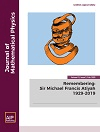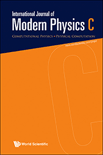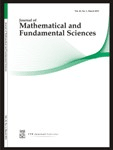
Journal of Rajasthan Academy of Physical Sciences
Scope & Guideline
Elevating Academic Excellence in Rajasthan
Introduction
Aims and Scopes
- Mathematical Modeling:
The journal emphasizes the development and application of mathematical models to describe complex physical systems, including fluid dynamics, thermodynamics, and biological processes. - Cosmological Studies:
There is a strong focus on cosmological models, particularly those utilizing different types of Bianchi models and their implications in general relativity and modified theories of gravity. - Statistical Analysis and Probability:
Research articles often explore statistical properties and distributions, with applications in various fields including survival analysis and waiting time problems. - Fluid Dynamics:
A significant portion of the journal's content pertains to the study of fluid flows, including MHD flows, viscous fluids, and their interactions with porous media. - Geometric Structures in Physics:
The journal explores various geometric and topological structures, such as Sasakian and Riemannian manifolds, and their relevance in theoretical physics. - Engineering Applications:
Papers also address engineering challenges, particularly in the development of electronic components and biomedical applications, showcasing the journal's interdisciplinary nature.
Trending and Emerging
- Interdisciplinary Research:
An increase in interdisciplinary studies that combine physics with engineering, biology, and computer science is evident, highlighting the journal's commitment to addressing complex real-world problems. - Advanced Fluid Dynamics:
Recent publications have shown a growing interest in advanced fluid dynamics, particularly in the context of non-Newtonian fluids and their applications in various engineering scenarios. - Nonlinear Dynamics and Chaos Theory:
There is a notable trend towards exploring nonlinear dynamics and chaos theory, particularly in cosmological models and fluid systems, indicating a shift towards more complex system analyses. - Applications of Hypergeometric Functions:
Research involving hypergeometric functions and their applications in various mathematical and physical contexts is emerging as a significant trend, demonstrating the journal's engagement with advanced mathematical techniques. - Biophysical Applications:
The journal is increasingly focusing on biophysical applications, particularly in modeling biological fluids and systems, which underscores the relevance of physical sciences in biomedical contexts.
Declining or Waning
- Classical Mechanics:
There has been a noticeable reduction in papers focusing on classical mechanics principles, possibly due to a shift towards more contemporary topics in fluid dynamics and cosmology. - Traditional Statistical Methods:
The frequency of studies utilizing traditional statistical methods appears to be waning, as more complex statistical models and computational approaches gain prominence. - Basic Thermodynamics:
Research specifically centered on foundational thermodynamics concepts has diminished, likely overshadowed by more complex analyses involving non-linear thermodynamics and MHD flows. - Elementary Geometric Properties:
There is a decline in publications dedicated to basic geometric properties, as the focus has shifted towards more intricate geometric structures and their applications in physics.
Similar Journals

JOURNAL OF MATHEMATICAL PHYSICS
Bridging mathematics and physics for innovative breakthroughs.Welcome to the JOURNAL OF MATHEMATICAL PHYSICS, a distinguished publication dedicated to the burgeoning fields of mathematical physics and statistical and nonlinear physics, published by AIP Publishing. Established in 1960, the journal continually showcases cutting-edge research and theoretical advancements that drive the understanding of complex systems and mathematical formulations within physics. With an impressive Scopus ranking of #38 in Mathematical Physics and #39 in Statistical and Nonlinear Physics, the journal is recognized for its vital contributions to the academic community, achieving a solid Q2 quartile ranking in both categories for 2023. While not an open-access journal, it remains a critical resource for researchers, professionals, and graduate students seeking insights into rigorous mathematical methods and their applications in physical sciences. Engage with the finest research as we converge toward new frontiers from 1960 to 2024, fostering academic collaboration and innovation.

INTERNATIONAL JOURNAL OF MODERN PHYSICS C
Fostering Global Dialogue in Computational TheoryINTERNATIONAL JOURNAL OF MODERN PHYSICS C, published by WORLD SCIENTIFIC PUBL CO PTE LTD, is a pivotal platform for disseminating groundbreaking research in the fields of computational theory, mathematical physics, and statistical physics. With an ISSN of 0129-1831 and an E-ISSN of 1793-6586, this esteemed journal, based in Singapore, serves a global audience of researchers and professionals who are dedicated to pushing the boundaries of knowledge in modern physics. The journal's rigorous selection process ensures the inclusion of high-quality articles that advance the understanding and application of complex theoretical concepts. Currently, the journal holds a commendable Q3 quartile ranking across several categories, including Computational Theory and Mathematics and Statistical and Nonlinear Physics, reflecting its influence and relevance in the academic community. Covering a wide array of topics from 1996 to 2024, the INTERNATIONAL JOURNAL OF MODERN PHYSICS C is not just a repository of research; it is a critical resource for students and scholars aiming to stay at the forefront of modern scientific inquiry.

Applications of Mathematics
Navigating the Intersection of Theory and ApplicationApplications of Mathematics, published by SpringerNature, is a respected journal based in the Netherlands that provides a platform for innovative research in the field of applied mathematics. Since its inception in 1997 and with a convergence ongoing until 2024, the journal supports the dissemination of high-quality scholarship, although it currently holds a Q4 category ranking in the applied mathematics category, which reflects its niche importance in the academic community. Researchers and professionals in the field can access a diverse array of applied mathematical techniques and their practical applications, contributing to advancements across various disciplines. While the journal does not operate under an open access model, it is indexed and ranked in Scopus, where it holds a rank of 419 out of 635, placing it in the 34th percentile. This underscores its value and relevance in the global research landscape.

Journal of Mathematics Mechanics and Computer Science
Fostering collaboration in mathematics, mechanics, and computing.Journal of Mathematics Mechanics and Computer Science is a pioneering open access journal published by AL-FARABI KAZAKH NATL UNIV, dedicated to advancing the field of mathematics and its applications in mechanics and computer science. Established in 2009, this journal aims to provide a platform for innovative research, encouraging the dissemination of high-quality, peer-reviewed articles that push the boundaries of mathematical theory and computational methods. Though the journal currently ranks within the lower quartiles in Scopus categories, it remains committed to fostering academic discourse and advancing knowledge in its scope areas. Located in Almaty, Kazakhstan, the journal also emphasizes accessibility, ensuring that all research is readily available to researchers, professionals, and students worldwide. With a focus on developing new theoretical frameworks and practical applications, the Journal of Mathematics Mechanics and Computer Science is an essential resource for those aiming to engage with cutting-edge developments in mathematics and computer science.

European Physical Journal H
Charting the Course of Physics Through Time and ThoughtThe European Physical Journal H (EPJ H) is a distinguished peer-reviewed academic journal dedicated to the history and philosophy of physics, published by SPRINGER HEIDELBERG in Germany. With an ISSN of 2102-6459 and an E-ISSN of 2102-6467, the journal aims to bridge the gap between historical context and contemporary scientific advancements in the field of Physics and Astronomy. Although it holds a Q4 quartile ranking in the 2023 category for Physics and Astronomy (miscellaneous) and occupies the 161st position out of 243 in Scopus rankings, EPJ H has a vital role in facilitating discourse among researchers and educators interested in retracing the evolution of concepts and discoveries within physics. Emphasizing the importance of interdisciplinary dialogue, the journal provides open access options to ensure that its scholarly contributions are readily available to a global audience, thereby enhancing educational resources and research visibility. The timeline of publication spans from 2010 to 2024, making it an up-to-date resource for those exploring the intricate historical landscape of physical sciences.

Korean Journal of Mathematics
Elevating the Standards of Mathematical Scholarship.The Korean Journal of Mathematics, published by the Kangwon-Kyungki Mathematical Society, is an esteemed platform dedicated to advancing the field of mathematics. With an ISSN of 1976-8605 and E-ISSN of 2288-1433, the journal features a range of scholarly articles that emphasize both theoretical and applied aspects of mathematics, catering to researchers, professionals, and students alike. Although it is not open access, the journal maintains a commitment to academic rigor and integrity, ensuring high-quality contributions to the mathematical community. As it converges from years 2021 to 2024, the Korean Journal of Mathematics is poised to enhance its visibility within the Scopus database, currently ranking #354 out of 399 in the general mathematics category, reflecting its potential for growth and impact in the mathematical sciences. With its strategic focus and institutional backing from Kangwon National University, the journal serves as a vital resource for fostering research and dialogue in the ever-evolving landscape of mathematics.

Journal of Mathematical and Fundamental Sciences
Bridging theory and application in mathematical sciences.Journal of Mathematical and Fundamental Sciences, published by INST TEKNOLOGI BANDUNG, serves as an essential platform for disseminating research findings in the diverse fields of mathematical and fundamental sciences. With an ISSN of 2337-5760 and recognized as an Open Access journal since 2013, this publication promotes global accessibility to innovative research, fostering collaboration among researchers, professionals, and students in Indonesia and beyond. The journal has demonstrated its influence within the academic community, evidenced by its classification in various quartiles for 2023, including Q3 in Agricultural and Biological Sciences and Mathematics, and Q4 rankings in several other disciplines. Furthermore, it holds respectable Scopus ranks across numerous categories, reflecting its commitment to quality and relevance in research contributions. With a focus on multidisciplinary studies, the Journal of Mathematical and Fundamental Sciences is dedicated to advancing knowledge and inspiring new ideas across a spectrum of scientific inquiries.

JOURNAL OF BIOLOGICAL PHYSICS
Unraveling the Physics of LifeThe JOURNAL OF BIOLOGICAL PHYSICS, published by Springer, is a premier interdisciplinary journal that focuses on the intersection of biological sciences and physics. With an ISSN of 0092-0606 and an E-ISSN of 1573-0689, this journal serves as a significant platform for researchers and professionals to publish innovative studies, covering fields such as atomic and molecular physics, biophysics, cell biology, and molecular biology. The journal has been a key player since its inception in 1973, showcasing rigorous scientific inquiry and advancing knowledge within these domains, reflected in its categorization in the Q3 and Q4 quartiles of various relevant fields as of 2023. While it currently operates without an Open Access model, the journal continues to provide pivotal contributions to its audience, supporting academic and practical advancements in biological physics while engaging a broad scope of scholarly discourse.

ANNALES HENRI POINCARE
Advancing the Frontiers of Theoretical and Applied PhysicsANNALES HENRI POINCARE is a prestigious journal published by Springer International Publishing AG, dedicated to advancing research in the fields of Mathematical Physics, Nuclear and High Energy Physics, and Statistical and Nonlinear Physics. With an impressive Q1 ranking in its respective categories as of 2023, this journal is recognized as a vital resource for academic researchers, professionals, and students engaged in frontier studies of theoretical and applied physics. The journal's commitment to high-quality peer-reviewed articles promotes significant contributions to the understanding of complex physical phenomena, making it essential reading for anyone seeking to stay abreast of developments in these dynamic fields. Additionally, ANNALES HENRI POINCARE offers open access options to enhance the visibility and accessibility of groundbreaking research, underscoring its role in fostering collaborative scientific inquiry and innovation. Since its inception in 2000, it has continually provided a platform for scholars worldwide to disseminate their findings and engage with the broader scientific community, thus establishing itself as a cornerstone of academic literature.

Journal of Geometry and Symmetry in Physics
Bridging Mathematical Theory and Physical RealityJournal of Geometry and Symmetry in Physics is a peer-reviewed academic journal dedicated to the exploration and dissemination of research at the intersection of geometry, mathematical physics, and symmetry principles. Published by the BULGARIAN ACADEMY OF SCIENCES, INSTITUTE OF MECHANICS, this journal plays a pivotal role in fostering interdisciplinary studies that leverage geometric insights to advance theoretical and applied physics. With an ISSN of 1312-5192 and an E-ISSN of 1314-5673, it serves as a crucial platform for both established and emerging researchers to share their findings. Boasting a 2023 Scopus ranking in the Q3 category for both Geometry and Topology and Mathematical Physics, the journal demonstrates its growing influence in these fields. Since its inception in 2004, it has continuously aimed to bridge gaps between mathematical theories and physical applications, welcoming contributions that enhance our understanding of fundamental symmetries and geometric structures. Though it operates without an open-access model, the journal remains committed to high-quality publishing standards, making it an essential resource for academics, practitioners, and students alike who are passionate about uncovering the mathematical fabric underlying physical phenomena.